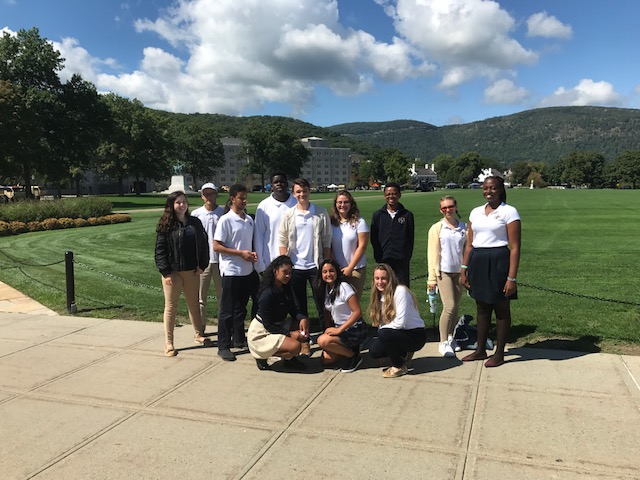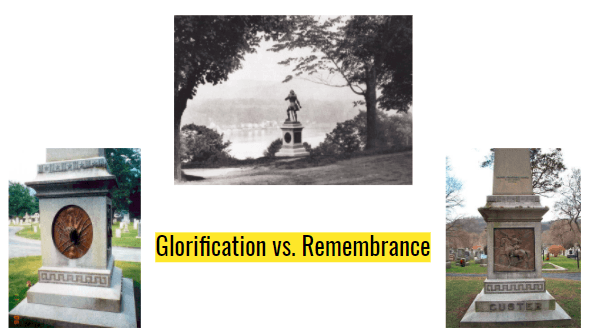Storm King Honors US Studies students used neighboring West Point as their classroom when they took on the controversial topic of addressing numerous calls for the removal of national monuments earlier this year. “Remembrance vs. Glorification” was the theme of the study where the class focused on several of the Academy’s historic statues and monuments. What began as a fictitious exercise asking the students to evaluate contemporary issues vis-à-vis historical facts concluded with a genuine letter of thanks from USMA Superintendent Lt. General Robert Caslen.
Students in the Honors US History class include Zay Megias ’18, Joan Kacyira ’18, Oluwatobi Akingbade ’19, Savannah Buon ’19, Emmanuel Davis ’20, Guy-Paul Delisfort ’20, Amelia Douches ’20, Sophia Grausso ’20, Jae Hyun Kim ’20, Naunet Leonhardes-Barboza ’20, Samantha McCullough ’20, Morgan Papera ’20, and Pierce Pramuka ’20.

Storm King’s Honors US History students at West Point
To kick off the project, the students were given a fictional letter from General Caslen outlining the monuments to be examined and the issues at hand. In the letter, Gen. Caslen charged the students with making recommendations that addressed concerns posed to the Academy as to why specific monuments needed to be revised or removed.
The project focused on General Custer’s grave at West Point and the question of his violent actions against Native Americans; Benedict Arnold’s plaque at the West Point Old Cadet Chapel and the question of his treason against America; George Washington’s statue on the Plain at West Point and questions of him as a slave owner; the Battle Monument at Trophy Point and the concern that many names listed on it are of Civil War leaders who participated in war crimes.

A slide from the class’ presentation
First and foremost, the students had to learn about the history behind each monument within the context of different periods of US History such as the Revolutionary War, the Civil War, and the period of westward expansion that resulted in the genocide of Native Americans. To bring themselves up to speed, the class journeyed to West Point to see the grave, plaque, statue, and monument first-hand. On another day, the students spent time at the West Point Museum to conduct further research.
A few weeks later the students were ready to present their findings. That’s when Colonel B.E. Atnavy (B. E. Atnavy = BEAT NAVY!) from the Superintendent’s staff paid the class a visit. To the students’ surprise, Col. Atnavy was actually an SKS faculty member – Ms. McMahon! An officer herself, she came to hear the students present wearing a Colonel uniform (Ms. McMahon had actually served on Gen. Caslen’s staff at West Point, so she set a realistic example).

The class received a hand-written note of thanks from Lt. General Caslen who is the Superintendent of USMA West Point
Once the students got past their surprise, they presented their findings and received sound advice from Ms. McMahon. Then turning fiction into fact, their final task was to prepare an official letter outlining their recommendations and strategies that would actually be sent to General Caslen. The Superintendent, who was very appreciative of our students’ contributions, sent the class a hand-written note of thanks, promising that he would use some of their recommendations as part of the larger strategy at West Point.
According to History Department Chair Michael Hauser this was an invaluable exercise that allowed the students to look at the contemporary issue of demands to take down monuments and historical sites in light of their historical context. “They took a mature and empathetic approach the solutions they suggested,” explained Mr. Hauser. “For instance, the class suggested a complementary monument to be built next to Custer’s grave to commemorate the loss of lives of Native Americans. Regarding the Battle Monument, George Washington’s statue, Custer’s grave, and Benedict Arnold’s plaque, they concluded that as a general practice, West Point should examine the legitimacy of each issue on a case-by-case basis in an inclusive process that makes sure to involve any organization calling for the removal or renovation of monuments, statues, or commemoratives. In short, they composed a very sensible process that West Point can actually implement.”
